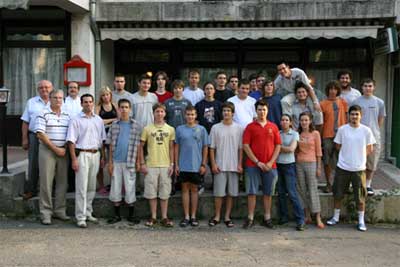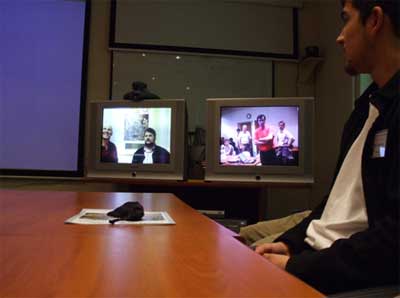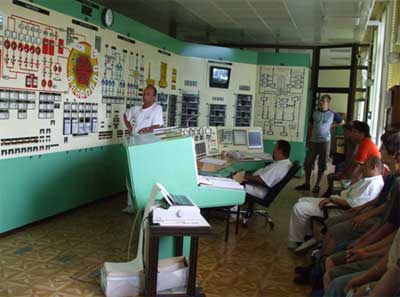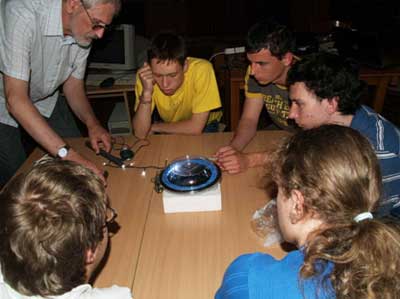
European
Nuclear Society
e-news
Issue 30 Autumn 2010
http://www.euronuclear.org/e-news/e-news-30/hns.htm

The future expansion of the nuclear industry requires a constant supply of qualified professionals. In Hungary, hundreds of workers at the Paks NPP are going to retire over the next ten years and many will need replacing. The life extension of a nuclear power plant, as well as the possible building of other plant units, requires additional professionals. This view is supported by the fact that in Finland the decision that led to the building of new units increased tenfold the number of the university students choosing to study nuclear energy.
The need to strengthen the training and education of nuclear professionals and provide further education for talented individuals had already become apparent several times before the spring of 2007, when the idea to organise a nuclear summer camp first came about. The organisation was carried out by the management of the Hungarian Nuclear Society (HNS) with the help of the society’s group of teachers and students (Youngsters for Nuclear Energy - YNE). The summer camps were supported by Paks NPP. The Eötvös Loránd University, and Budapest University of Technology and Economics also provided great help with the organisation of the measuring and monitoring tasks.
To reach the overriding goal – to motivate students to want to study nuclear technologies – the organisers created diverse, high-quality educational programmes, while at the same time emphasising the importance of receiving a good basic theoretical and practical education. Lectures were given by scientists, university professors and researchers. In addition to these lectures from experienced experts, the programme also featured computer simulation exercises and measuring and monitoring experiments. Despite the tight schedule students also had an opportunity to relax and to visit nuclear facilities.
At the summer camps teachers, young scientists and students took care of participants. At the end of the camps participants received certificates, t-shirts and CDs featuring the materials from the lectures and photos taken at the camp.

Participants of the first Nuclear Summer Camp (2007)
In June 2010, the fourth Nuclear Summer Camp took place. These one week long camps - in which high school students from all parts of the country participated - were located in the neighbourhood of Budapest because of the easy access it affords.
In these four years since the first camp was organised there have always been a number of returning students, as well as first-timers. One student has taken part in all four camps. Consequently, the programmes were devised for both beginners and advanced students.
On the first day of every camp the “beginners” were taught the basics of nuclear physics. We wanted to avoid repetition and so different aspects of the same topics were presented. In addition, lectures also featured well-known adaptations of nuclear measurement techniques. After teaching the basic notions of the measurement techniques, the measurement tools – those which are suitable for detecting radiation – were explained. Experts talked about many things from basic neutron-physics to the difficulty of detecting the neutrinos. At the first camp, students could follow the research of CERN via a videoconference link. They had the opportunity to talk to Hungarian scientists working there. Furthermore, every year’s programme included lectures about particle physics.

Videoconference with CERN (2007)
In addition to these programme elements there were many current issues to talk about. The invited experts reported on the increasing importance of climate change, the difficulties associated with the various ways of using renewable energy sources and the national and international nuclear energy scene. There were also lectures about the capacity increasing programmes of the nuclear power plants, service lifetime extension, the accident at Paks NPP and the experiences learned from it and safety questions relating to nuclear reactors. The students also were given information about the storage of domestic nuclear waste and the possible location of the European Spallation Source (ESS) facility in Hungary.
Participants also listened to lectures about additional applications of nuclear technology, including the relationship between nuclear technology and material science, the various methods of analysing materials, the medical usage of radioisotopes and the military use of nuclear energy. Lectures about the magnetic confinement of plasma and about the ITER (International Thermonuclear Experimental Reactor) programme provided information about the most successful research projects that have focused on fusion and about its possible applications. A lecture on the thermo-luminescent dosimeter (TLD), which was developed by The Hungarian Academy of Sciences and the KFKI Atomic Energy Research Institute, was much appreciated because it used material gathered by Charles Simonyi Jr. during his mission in space. At every summer camp lectures on the history of science were also given.
The lectures were followed by study trips. During the four years since the summer camps’ creation participants have taken part in visits to the Paks NPP and KFKI. These provided them with a chance to see the research reactor and training reactor there.

Study trip to the research reactor in KFKI (2007)
Each year, participants have also visited Eötvös Loránd University, where after the lectures, they had a look at the nuclear astrophysics and chemistry laboratories, where they got acquainted with the recent research activities carried out there.
In the second year, students visited the low and high-level radioactive waste disposal facility. The students were impressed by having the chance to monitor and measure radiation doses thanks to the mobile detectors. They were also able to test the manipulator which the staff uses to select radioactive waste.
After the first two summer camps subsequent ones were organised outside Budapest, in response to participants’ requests. In 2007, a group went to Debrecen where students took part in lectures and visited the PET/CT Center at the University of Debrecen and the Nuclear Research Institute, where they could follow interesting experiments. After the second summer camp students went to see the MRI and CT scanning equipment at the Regional Hospital of Miskolc.
Every year, following the lectures on theory, students carried out their own research. Every year, they have built a cloud chamber, analysed gamma spectra and carried out measurement exercises. One regular activity at the camps is the “measuring car” of Paks NPP.

Building of cloud chamber (2010)
The project assignments given to the students also proved a success. Students in groups of 5-6 were asked to solve problems using the lecture materials, the equipment provided and the Internet. In the second year, students were asked to deliver a lecture on the main features and technological structure of a third-generation power-plant of their choice and to highlight the need for building new power plant units. Throughout the preparatory phase of their assignments students could ask the help of the guest lecturers. Guests were invited (playing the role of anti-nuclear energy activists) to attend the lectures given by students and some very interesting discussions developed on the necessity of nuclear power plants and the pros and cons of the various types of plants.
In the camps games and sports activities were also organised. Students played football, table-tennis and tennis and swam in an open-air pool. At the campsite bonfire very interesting conversations with the organizers and senior members of the Hungarian Nuclear Society took place. These activities were very popular with the students.
Nowadays, it is well-known that physics is not popular in schools. The universities complain about the level of the students. Their knowledge of physics is getting worse. A survey examining the general standard of students shows that those who took part is physics competitions or in further education programmes devoted to physics are more successful in the field. The HNS assists pupils who finished in the first three places in the Szilard Leo Competition7 (the main subject of the competition is atomic physics).
It is very important to support talented pupils. The consensus is that the summer camps were successful. They have achieved their objective. Participants grew to enjoy nuclear physics. It is a proven fact that a lot of former participants went on to study physics at university.
Some of the personal experiences at the summer camps were summarised by Kata Kovacs, who took part in all of the four summer camps.
“I am a first year student at the Budapest University of Technology and Economics, where I study physics. To me this camp means a lot because it is the place where I finally decided that I would like to study physics later on I would like to work in the nuclear industry. It was quite reassuring that every year different people did different jobs at establishments waiting for young physicists. I know that when I finish my studies I have a very good chance of finding a job from which I could earn enough money to keep my future family in financial security.
I also think these camps are very important because students get to hear about current issues which concern them and which future scientists will solve. In school, teachers usually teach from textbooks that are not up-to-date and there is no time set aside during the school year to talk about interesting, modern inventions or ideas. This camp is a place where participants hear about current issues and events in the world from professionals who are happy to answer questions too.
Every year there is an introduction to nuclear physics for those students who don’t have any knowledge of this field of physics. This introduction is held by Andras Mester, who uses a lot of illustrations to help the younger students understand. In this way, everyone can take an active part in all activities regardless of their age and former education. During the five days of the camp it’s very easy to learn a lot more than what is needed to pass the school leaving exams, which in Hungary are taken at the end of middle school.
The most important point for me is that I have been reassured that what I study now is hard, but is worth the effort because I will see a lot of benefits in the future. Also, as I have attended all four camps I have learned much more about the nuclear industry than I would have ever had a chance to at another place. As the middle school students from the camp finished their studies there were always a couple who decided to study physics at university, based on what they had seen at the camp.
This year I was the one who finally finished middle school and moved on to study physics at university. As I look back I think I wouldn’t have chosen physics if I hadn’t been to this camp. There are many reasons for it. First of all, most people don’t know what kind of job a person with a BSc or MSc (or PhD) in physics will get. Secondly, is that it is hard to pass the exams, so people need to be sure that it is worth the effort. Third, it’s not one of the most popular courses, so most students don’t even think about studying physics. This view exists only because people don’t know a lot about physics. At the camp all of these myths are dispelled, so the camp has great significance because it shows the future generation a path which they can follow.”
Andras Mester
Chairman of the Teacher's Expert Group of HNS
References:
www.szilardverseny.hu/
mnt.kfki.hu/Nukleon/
paksnuclearpowerplant.com/
mnt.kfki.hu/index.php?page=&lang=en
© European Nuclear Society, 2010